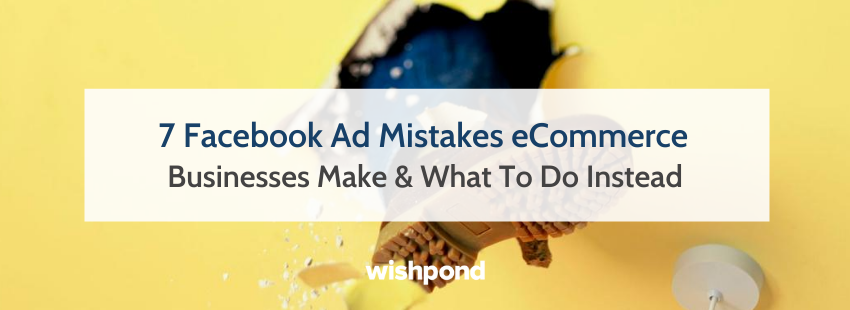Facebook ads are becoming an increasingly popular marketing method for Shopify and other eCommerce sellers like you. When used effectively, they can help you target your ideal customers, stand out from your competition, and boost sales.
But if you go about your Facebook ads strategy the wrong way, you’ll ultimately be throwing money behind campaigns that don’t generate awareness, interest or sales.
To help you master Facebook ads, we put together the following guide with seven common mistakes eCommerce businesses make with their Facebook ads — plus, how to avoid them and keep your ads strategy in tip top (selling) shape. Let’s dive in.
Mistake #1: Not using automatic placements
When you use Facebook ads, you have access to Facebook’s entire suite of platforms, including Facebook, Instagram, Whatsapp, and Messenger. Where your ad appears — whether it’s on the Facebook News Feed, as an Instagram Story, or elsewhere — is referred to as a “placement”.
There are two ways to go about these placements. On one hand, you can set them manually. On the other, you can do them automatically through Facebook’s “Automatic placements”.
You’ll be able to select your placement preference under “Placements” in the “Ad Set” stage of your campaign creation in Facebook ads manager, as shown here:
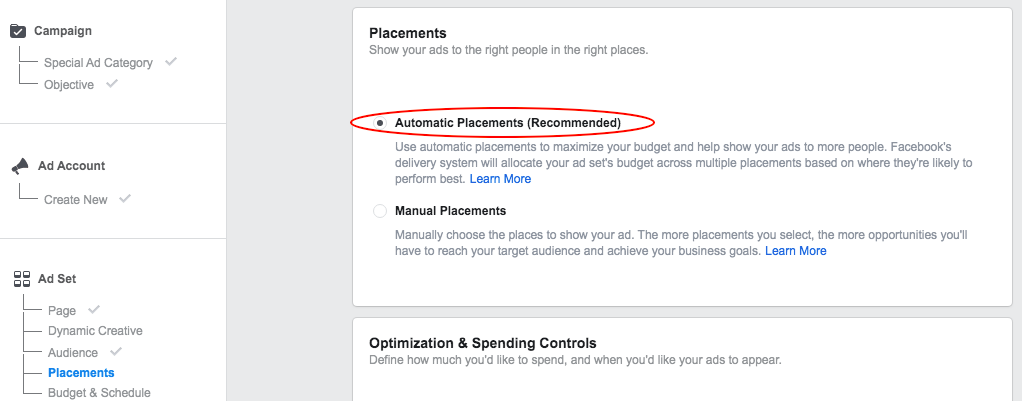
The biggest mistake we see here is with sellers opting to manually place their ads. While this might provide you with a sense of control over your ad campaign, it requires a lot more research (not to mention trial and error) on your part. And if you don’t pick the right placements, you could end up blowing your ad budget.
With automatic placements, Facebook does the heavy lifting for you so you can target the right people with the right ads in the right place — all at the lowest possible cost to you. You can essentially “set it and forget it” while Facebook’s algorithm takes care of the rest.
Speaking of which, head to mistake #2 to learn the dos and don’ts of Facebook’s algorithm.
Mistake #2: Not leveraging Facebook’s algorithm
As we just mentioned, Facebook’s algorithm can determine where and when to place your ads so they reach your target audience when they’re most likely to engage. This, of course, helps ensure that you’re not wasting your ad spend.
If you notice that a campaign isn’t performing to your expectations, you might be tempted to tweak the campaign parameters, whether it’s placement, audience, even creative. This, we see, can be a mistake.
Here’s why: Editing a campaign too quickly essentially prevents Facebook’s algorithm and machine learning from optimizing for you.
Through its “Power5” automated ad tactics, Facebook will automatically optimize your campaign budget by identifying which ad sets aren’t performing well, which ones are, and reallocate spend accordingly.
But this might not happen overnight. Our recommendation is to give your campaign (and the Facebook algorithm) a few days to adjust before you go in and do anything yourself.
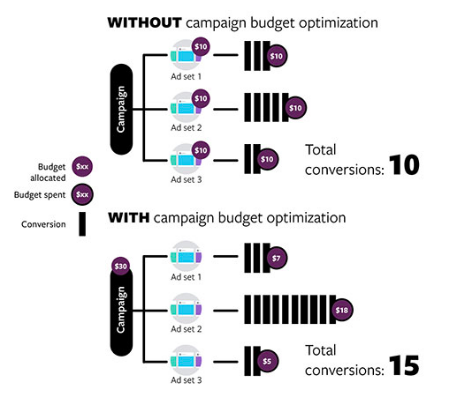
As you can see in the above graphic, leveraging Facebook’s algorithm to optimize your ad spend should yield you more conversions than doing it manually.
Mistake #3: Ignoring dynamic ads
With Facebook Dynamic Ads, you can share your product catalog in your ads to further entice both warm and cold leads. While they can be used for prospecting, they are extremely effective at retargeting.
In fact, Dynamic Ads can convert your hottest leads — you know, the ones who abandon their carts or spend time browsing your products without actually buying anything.
When you use the Facebook pixel (more on that below), you can track which website visitors look at which products on your website, including those that they add to their carts but don’t purchase.
And when used together, your Facebook pixel and Dynamic Ads can show an ad with the actual product(s) they viewed and/or left in their carts alongside ad copy like “Forget something?” or “Still interested?”
Here’s how to set up a Dynamic Ad:
- Create Catalog: Go to www.facebook.com/products and click the blue “Create Catalog” button. This will bring you to the Catalog Manager where you can upload your product(s) or do an auto-import.

- Install & Connect Your Facebook Pixel: The Facebook pixel is a 15-digit code generated by Facebook that you add to your website to “measure the effectiveness of your advertising by understanding the actions people take on your website.” It tracks things like website visits, add-to-carts, purchases, and more. In Shopify, there is a field under Online Store >> Preferences where you can copy and paste your Facebook Pixel code. From there, you can upload your products and even enable Facebook checkout. Learn more about this here.
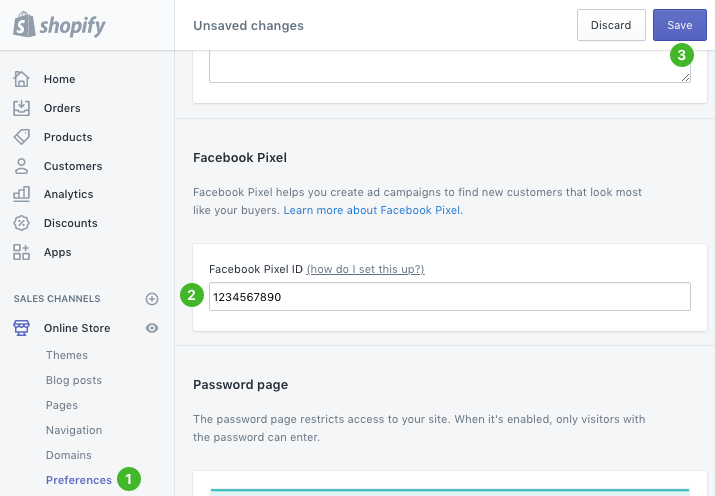
- Create Dynamic Ad: In Ads Manager, create your campaign, choosing “Catalog Sales” as your marketing objective and selecting the catalog you just created. Then create your ad set and follow the prompts so you choose relevant products, text, audience, placement, budget, and more. If you’re creating a Carousel (where your ad shows multiple products/images from your catalog in the same ad), you can add a card to the carousel that links to your Facebook Page. Don’t forget to add a call-to-action button that links back to your Shopify store where viewers can complete their purchases.
All in all, if you don’t use Dynamic Ads, you’re missing out on a lot of potential sales. Not to mention, you’re losing another opportunity to build brand and product awareness with folks who are still “cold”.
Mistake #4: Not capturing emails
Many marketers and entrepreneurs say that a business’s most valuable asset is their email list. After all, it’s something you “own” — unlike your social media followers, for example.
Let’s consider this very unlikely scenario: if Facebook or Instagram suddenly shut down or stopped allowing eCommerce sellers to use their social platforms, all your followers and social media klout would disappear. You wouldn’t be able to reach or engage with this warm audience anymore.
With an email list, you can reach them regardless of the state of social media.
Chances are, you’ve grown an email list from existing and former customers. Maybe you even have an email opt-in form or pop-up on your website where not-yet-customers have signed up for a coupon code or other perk.
But are you also leveraging Facebook ads to capture emails?
Not all of your Facebook ads need to sell a product. You can use them to build brand awareness and capture leads. Just choose “Lead Generation” as your object and then select the “Sign Up” call-to-action.

As you start building your email list, you’ll be able to create targeted email campaigns that supplement your Facebook ad campaigns.
Need help with your next Facebook ad?
Book a free call to learn how our team of marketing experts can help you to create high converting Facebook ads today.
Mistake #5: Setting more than one campaign budget
Depending on the size of your eCommerce business, you’ll likely have multiple ads running at one time. This does NOT mean you should also have multiple budgets running at one time, however.
Remember that graphic we shared under Mistake #2 above, showing what campaign budget optimization can do for your conversions? Let’s look again, but this time pay close attention to how budget is allocated for each scenario:

As you can see, the “without” scenario has the entire $30 budget split up equally between the three ad sets. While this seems like a logical approach, it doesn’t keep optimization in mind.
Let’s dig a little deeper. According to this graphic, Ad set 3 is the lowest-performing of the three. But the first example still has the $10 budget going toward it — even though it’s not generating a lot of conversions.
In the other example, the $30 budget is set as the ONLY budget, allowing Facebook to take spend away from Ad set 3 and redirecting it towards the highest-performing Ad set 2.
This, in turn, should lead to more conversions — and smarter spending.
All in all, one overarching campaign budget will allow the Facebook algorithm to better optimize your spend so you get the most conversions for the least investment.
Mistake #6: Not using financing to scale your growth
If you’re like most eCommerce sellers and find it hard to maintain steady cash flow, then running Facebook ads consistently might be a challenge. Of course, you’d set a budget that you know you could afford on a regular basis, but let’s face it: surprises happen, especially in eCommerce.
Such surprises could be a flash sale on inventory that your supplier is running for one day only — if you can move a few things (i.e. budgets) around to take advantage of it, you could increase your margins. Or, demand could suddenly spike, forcing you to allocate your budget to rush inventory orders so you can avoid stocking out.
Not to mention, if your Facebook ads or any other advertising you are doing is ROI positive, you should do more of it ASAP.
You can market to your audience faster and more effectively with financing. However, the funds you need to reinvest in advertising are by design going to predate your actual sales. But, if you’re not using financing to scale your advertising efforts and make more sales, you could be leaving money on the table.
Whatever the case may be, you’ll want to have a reliable source of cash so you can act quickly in times of surprise or opportunity and still keep your Facebook campaigns running — especially if they’re providing a positive ROI.
One cash flow strategy many eCommerce sellers implement is getting financing. With the right financing partner, you can leverage opportunities that grow your bottom line — including Facebook ad campaigns.
If you’re realizing that you need a cash flow boost to keep your ROI-positive ads going, check out Payability, a financing company for eCommerce sellers.
Payability offers a variety of cash flow solutions to sellers just like you, with one being Instant Advance for Shopify.
With Instant Advance for Shopify, Payability would buy a certain amount of your receivables up front and at a discount, giving you a large lump sum of cash that you can use for your Facebook ads budget and/or another growth opportunity (such as that hypothetical flash inventory sale we just mentioned).
None of Payability’s solutions are loans, so you won’t be on the hook for any interest payments — nor will you have to get a credit check to be approved.
Instead, you’ll pay a flat fee (typically between 0.5% and 1% each week) and be eligible for rebates if you pay back early. Decisions are based solely on your account health and selling performance, and you could get funding (typically 75% to 150% of one month in Shopify sales revenue) in 24 hours.
Payability’s solutions also work well alongside the other financing options you may already have in place such as Amazon Lending, Shopify Capital, or a line of credit from your bank.
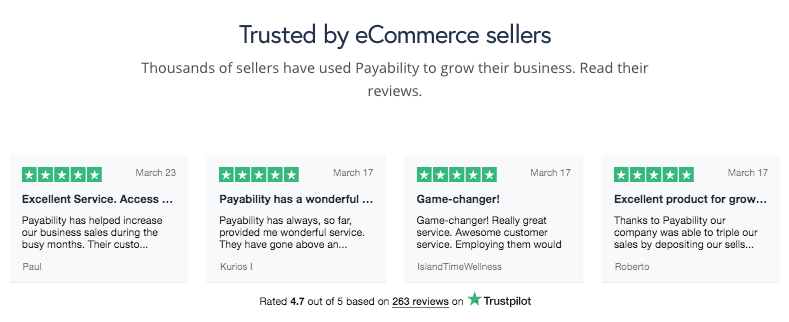
For other cash flow needs you might have — like accelerated daily payments and/or capital advances for inventory and marketing — Payability can help. Visit go.payability.com/Wishpond to learn more about how thousands of eCommerce businesses use Payability to invest in growth opportunities and boost their bottom lines.
Mistake #7: Only relying on Facebook ads for marketing
You’ve heard the saying: “Don’t put all your eggs in one basket.”
In this case, don’t spend all your marketing budget on Facebook ads alone. Investing in other marketing and sales channels will help you further build your brand and acquire new customers. Not to mention, it will let you see what marketing efforts produce the best ROI for your Shopify store.
As you’re creating your 2H 2020 marketing plans and looking ahead to 2021, don’t forget to leverage strategies like:
Wishpond can help with a number of these (and more) marketing solutions.
Wrapping Up
At the end of the day, you can leverage the power of Facebook ads to boost your Shopify sales, increase customer loyalty, and attract new buyers. Just make sure you follow a smart Facebook ads strategy that ultimately gets you the best results for the least amount of spend — all while maintaining a reliable cash flow.
About the Author:
Victoria Sullivan is a Marketing Manager at Payability. She has over eight years of social media, copywriting and marketing experience. Prior to joining the Payability team, Victoria developed social media content and strategies for top technology brands such as Skype and Samsung.

